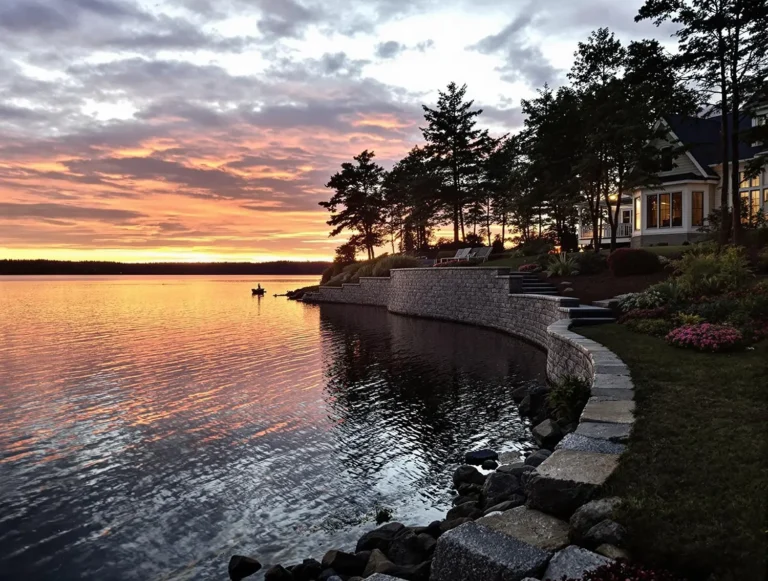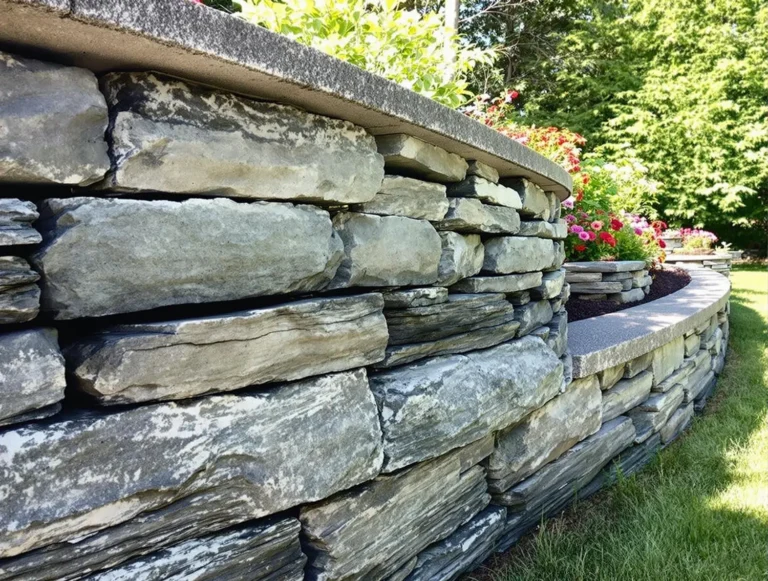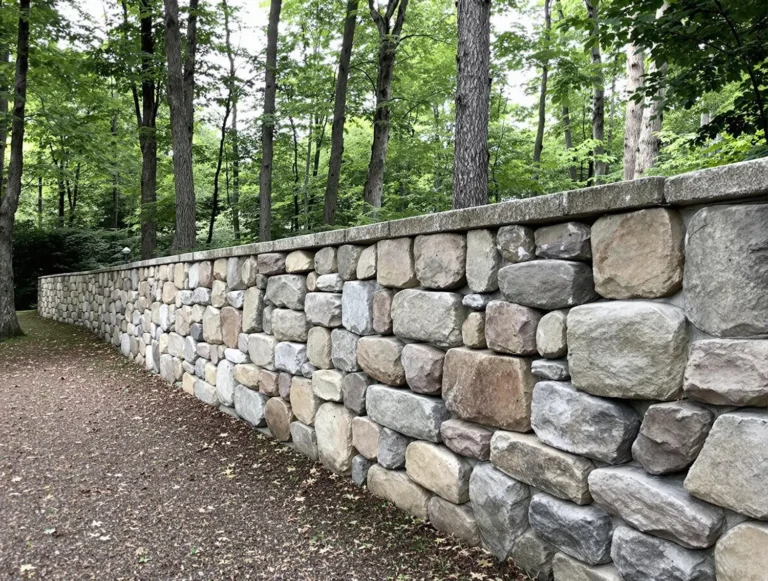Armour Stone Retaining Walls: The Ultimate Guide for Muskoka Homeowners
Are you dreaming of a stunning, durable landscape that stands the test of time and Muskoka’s unique climate? Armour stone retaining walls are a top choice for homeowners looking to enhance their property’s beauty, functionality, and value. Whether you’re planning a grand lakeside terrace or simply want to tame a sloped yard, this guide walks you through everything you need to know about armour stone retaining walls in Muskoka.
Table of Contents
What Is Armour Stone?
Armour stone is a large, rugged, natural stone quarried for its strength and beauty. It’s typically limestone or granite, sourced from local quarries in Ontario, including Muskoka and surrounding regions. Unlike manufactured concrete blocks, each piece of armour stone is unique, offering a one-of-a-kind look that blends seamlessly with Muskoka’s natural landscape.
Local Sources & Types
Muskoka’s natural landscape offers an abundance of high-quality armour stone, sourced directly from local quarries. The most popular choices for retaining walls in the region are limestone and granite, each bringing its own unique beauty and benefits to your outdoor space.
- Limestone Armour Stone: Known for its neutral tones and smooth texture, limestone is widely used in Muskoka landscapes.
- Granite Armour Stone: With its speckled appearance and superior durability, granite is ideal for homeowners seeking a dramatic, high-end look.
- Other Varieties: Some local quarries offer sandstone or dolomite, though limestone and granite remain the most popular.
Benefits of Armour Stone
Armour stone offers a range of advantages that make it a preferred choice for landscaping projects in Muskoka and beyond. Its unmatched natural beauty, strength, and sustainability ensure your retaining wall is both visually striking and built to last in Ontario’s demanding climate.
- Natural Beauty: Each stone is unique, creating a timeless, organic look.
- Durability: Armour stone stands up to Muskoka’s freeze-thaw cycles, heavy rains, and harsh winters.
- Versatility: Perfect for retaining walls, garden borders, steps, and water features.
- Low Maintenance: Once installed, armour stone requires minimal upkeep compared to wood or concrete alternatives.
- Eco-Friendly: Sourced locally, reducing transportation emissions and supporting Ontario’s quarry industry.
Why Choose Armour Stone for Retaining Walls in Muskoka’s Climate?
Muskoka’s landscape is renowned for its rocky terrain, rolling hills, and beautiful lakes—but this also means homeowners face unique challenges. Here’s why armour stone is the best choice for retaining walls in this region:

1. Superior Strength in Harsh Conditions
Armour stone is naturally resistant to cracking, shifting, and erosion, even during Muskoka’s harshest winters. Its weight and density allow it to withstand pressure from soil and water, making it ideal for holding back slopes or creating terraced gardens.
2. Aesthetic Harmony with Muskoka’s Environment
The organic shapes and natural colours of armour stone blend perfectly with local forests, granite outcroppings, and lakefronts. Whether your home is a modern cottage or a classic Muskoka retreat, armour stone complements every style.
3. Longevity and Value
Unlike timber or basic concrete blocks, armour stone walls can last for decades with minimal maintenance. This longevity adds significant value to your property and reduces long-term repair costs.
How to Build an Armour Stone Retaining Wall: Step-by-Step Process
Building an armour stone retaining wall is both an art and a science. Here’s a professional overview of the process Muskoka Landscapes & Design follows to ensure lasting, beautiful results:
1. Site Assessment & Planning
- Evaluate the Landscape: Assess slope, drainage, soil type, and access.
- Design the Wall: Determine wall location, height, length, and layout. Consider curves or terraces for added interest.
- Obtain Permits: For walls above a certain height, local bylaws may require permits or engineering approval.
2. Excavation & Base Preparation
- Mark the Area: Outline the wall’s footprint with stakes and string.
- Excavate: Dig a trench below the frost line (typically 6–12 inches deep) and wider than the base stones.
- Install Base Material: Add a 6–8 inch layer of compacted crushed gravel for drainage and stability.
3. Laying the First Course
- Set the Base Stones: Position the largest, flattest armour stones as the first row. This foundational layer determines the wall’s strength and alignment.
- Level Each Stone: Use a level and rubber mallet to ensure a perfectly flat, stable base.
4. Building Up the Wall
- Stack Stones Carefully: Stagger joints for stability, fitting each stone snugly to minimize gaps.
- Backfill as You Go: Add gravel behind each layer for drainage and to prevent soil pressure.
- Check Alignment: Regularly step back and check the wall’s straightness and appearance.
5. Finishing Touches
- Cap Stones (Optional): Use larger, flat stones for a polished top row.
- Landscaping: Add soil, mulch, or plantings to blend the wall into your landscape.
- Clean Up: Remove excess gravel and debris, ensuring a tidy, finished look.
Tip: Professional installation ensures proper drainage, stability, and compliance with local regulations. DIY attempts can be rewarding but are best for small, low walls.

Cost Factors & Budgeting Tips
The cost of an armour stone retaining wall in Muskoka varies based on several factors:
1. Wall Size & Complexity
- Length & Height: Larger, taller walls require more stone and labour.
- Curves & Terraces: Complex designs may increase material and installation costs.
2. Stone Selection
- Type of Stone: Granite is generally more expensive than limestone or sandstone.
- Stone Size: Larger stones offer a bolder look but may require heavier equipment.
3. Site Conditions
- Access: Difficult-to-reach locations can increase labour and equipment costs.
- Soil & Drainage: Poor soil or challenging drainage may require additional preparation.
4. Labour & Equipment
- Professional Installation: Skilled labour ensures safety, longevity, and compliance but comes at a premium.
- DIY: Cost-saving for small projects, but mistakes can be costly to fix.
5. Permits & Engineering
- Regulatory Costs: Some projects may require permits or engineering, especially for walls over 1 meter in height.
Budgeting Tips
- Get a Detailed Quote: Ask for an itemized estimate from your contractor.
- Plan for Extras: Set aside 10–15% for unexpected site conditions or design changes.
- Invest in Quality: Higher upfront costs for quality stone and professional installation pay off in durability and curb appeal.
Maintenance of a Retaining Wall in Muskoka’s Weather
One of the biggest advantages of armour stone is its low maintenance needs, even with Muskoka’s freeze-thaw cycles and heavy precipitation.
Maintenance Checklist
- Annual Inspection: Check for shifting stones or minor settling, especially after winter.
- Weed Control: Remove weeds between stones to maintain a clean look.
- Drainage: Ensure gravel backfill and weep holes remain clear to prevent water buildup.
- Occasional Cleaning: Power wash or brush stones to remove dirt and algae.

Longevity of Armour Stone Retaining Walls
One of the standout advantages of armour stone retaining walls is their exceptional lifespan. When installed professionally and maintained properly, these structures can last for 50 years or more—often outlasting many other landscaping materials.
Why do armour stone walls last so long?
- Natural Durability: Armour stone is a dense, heavy natural material—typically limestone or granite—that resists weathering, cracking, and erosion far better than timber or concrete alternatives.
- Resistance to Freeze-Thaw Cycles: Muskoka’s climate brings harsh winters and frequent freeze-thaw cycles, which can cause other materials to shift, crack, or deteriorate. Armour stone’s mass and natural composition allow it to withstand these cycles without losing structural integrity.
- Minimal Maintenance Needs: Unlike wood, which can rot or attract insects, or concrete blocks that may shift over time, armour stone requires very little upkeep. Occasional inspections, basic cleaning, and ensuring proper drainage will keep your wall looking and performing its best for decades.
- Structural Stability: The sheer weight and size of armour stones provide inherent stability, making them less prone to movement or failure—even on sloped or challenging terrain.
What impacts the lifespan of an armour stone wall?
- Professional Installation: Proper base preparation, drainage, and careful stacking are critical to maximizing longevity. A poorly installed wall, regardless of material, will not last as long.
- Site Conditions: Walls built on well-drained, stable soil will last longer than those exposed to persistent moisture or shifting ground.
- Stone Selection: Choosing high-quality, locally sourced stone suited to Muskoka’s environment ensures your wall stands up to the elements.
Real-World Results:
Homeowners across Muskoka, Barrie, and Gravenhurst have enjoyed the enduring beauty and function of armour stone retaining walls for decades. Many original installations from the 1970s and 1980s are still standing strong today, a testament to the material’s lasting value.
FAQ
How long does an armour stone retaining wall last?
With professional installation and occasional maintenance, armour stone walls can last 50 years or more.
Is armour stone better than concrete blocks for retaining walls?
Armour stone offers a more natural look, superior durability, and blends beautifully with Muskoka’s environment. Concrete blocks are cost-effective and uniform, but may not have the same longevity or aesthetic.
What’s the best time of year to build a retaining wall in Muskoka?
Spring through early fall is ideal, as the ground is thawed and conditions are optimal for excavation and stone placement.
Can I build an armour stone wall myself?
Small, low walls may be DIY-friendly, but professional installation is recommended for larger or structural walls to ensure safety and compliance.
Do I need a permit for a retaining wall?
Walls over a certain height (often 1 meter) may require permits or engineering approval. Always check local bylaws or consult your contractor.
How much does an armour stone retaining wall cost?
Ready to Transform Your Landscape with Armour Stone?
Contact Us for a Free Consultation
Ready to embrace the latest landscaping trends in Muskoka? Contact us today at [email protected] or call 1 866-699-2221 for a free consultation.. Let our expert team bring your vision to life with natural stone features, sustainable designs, and luxurious outdoor spaces for your home, cottage, or business.”
